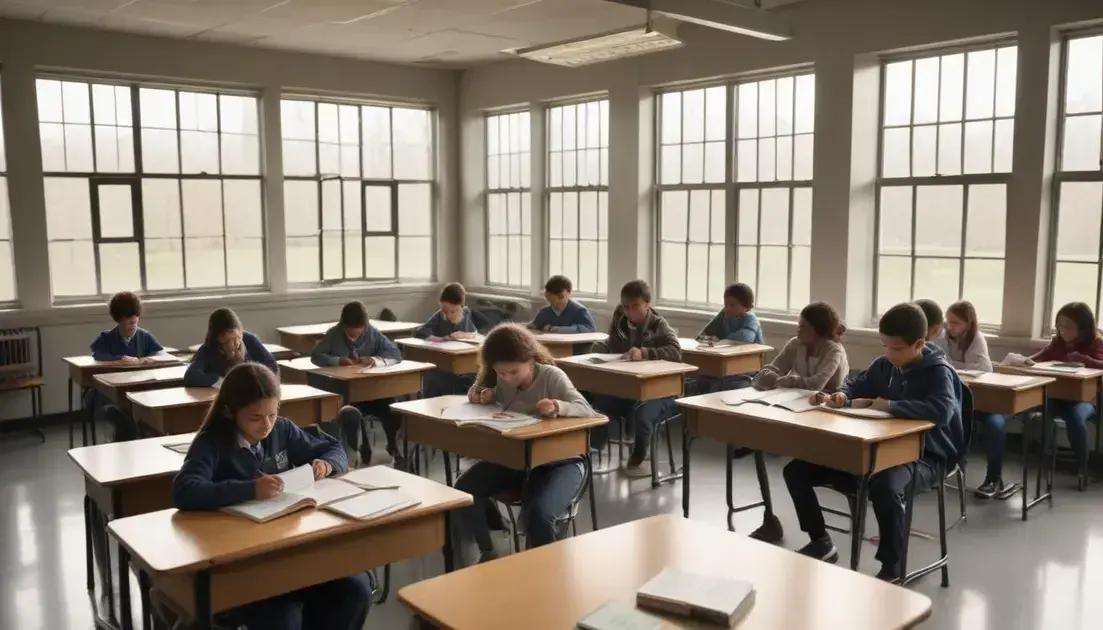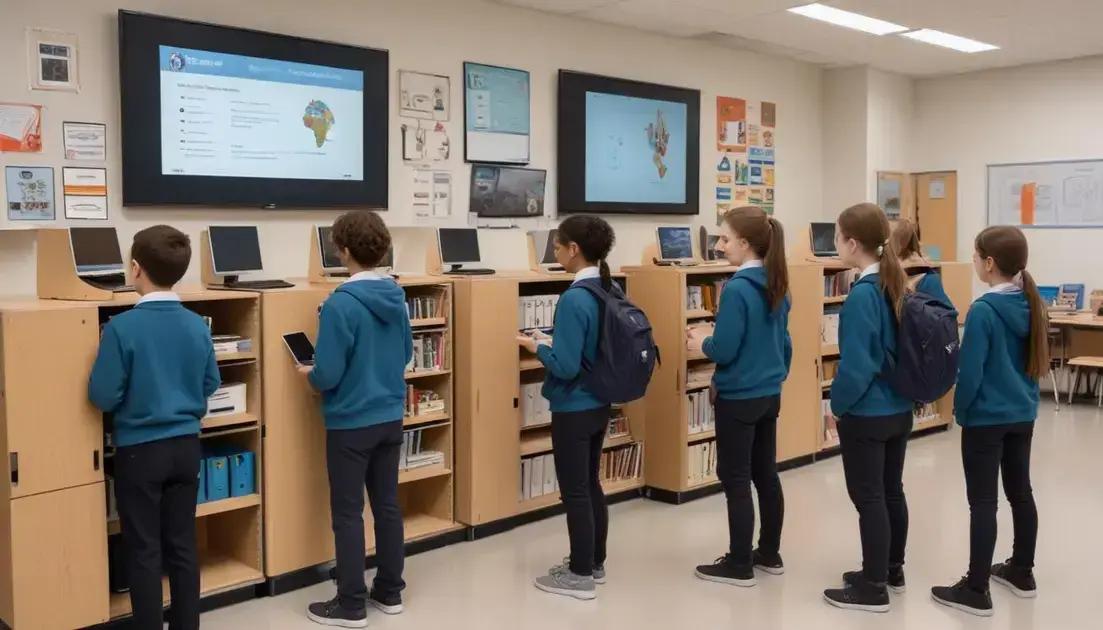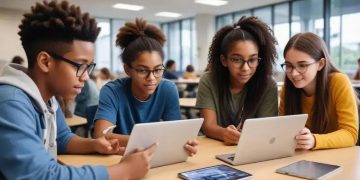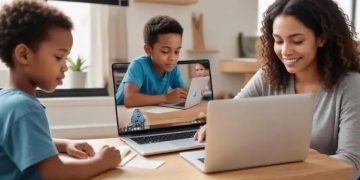School smartphone ban: how digital detox transforms student learning

School smartphone bans are strategic interventions that reduce digital distractions, improve classroom engagement, and support students’ mental health by implementing comprehensive digital management policies that prioritize learning and interpersonal skills development.
The school smartphone ban is rapidly emerging as an innovative solution to address digital distractions and restore meaningful learning experiences. Have you ever wondered how constant device access impacts students’ ability to concentrate and interact meaningfully? This comprehensive exploration reveals the transformative potential of creating tech-free educational spaces.
The rising challenge of smartphone addiction in schools
The digital era has transformed how students interact with technology, creating an unprecedented smartphone addiction crisis in educational settings. Recent studies reveal alarming statistics about students’ excessive device usage, showing unprecedented levels of screen time during school hours.
Measuring the Scope of Digital Dependency
Research indicates that teenagers now spend approximately 7-9 hours daily on digital devices, with smartphones becoming the primary source of constant digital stimulation. This continuous connectivity disrupts learning processes, attention spans, and social interactions within classroom environments.
Psychological Impacts of Constant Connectivity
Smartphone addiction among students leads to significant psychological challenges, including increased anxiety, reduced cognitive performance, and diminished interpersonal communication skills. Neurological studies demonstrate how frequent digital interactions can rewire young brains, potentially compromising critical developmental processes.
Educational institutions are increasingly recognizing the need to address this growing technological dependency. Implementing strategic interventions becomes crucial to restore meaningful learning experiences and protect students’ mental and academic well-being.
Behavioral Patterns and Warning Signs
Identifying smartphone addiction involves observing specific behavioral indicators: compulsive checking, emotional distress when devices are unavailable, declining academic performance, and reduced face-to-face social interactions. These symptoms highlight the profound impact of digital overconnectedness on student development.
Psychological impacts of constant digital connectivity
Constant digital connectivity is transforming the psychological landscape of modern society, particularly among younger generations. Neurological research reveals profound changes in brain function and emotional processing triggered by continuous digital engagement.
Cognitive Processing and Attention Span
Persistent digital stimulation significantly reduces cognitive capabilities, causing measurable decreases in attention span and information retention. Studies demonstrate that individuals experiencing constant digital bombardment struggle with deep concentration and complex problem-solving skills.
Emotional Regulation Challenges
Digital connectivity creates complex emotional patterns characterized by immediate gratification, social comparison, and heightened anxiety. Dopamine-driven feedback loops from social media interactions can lead to addictive behavioral patterns, disrupting natural emotional development and interpersonal relationships.
Neuropsychological assessments indicate that excessive digital exposure can trigger heightened stress responses, potentially rewiring neural pathways associated with emotional regulation and mental resilience.
Social Interaction and Empathy Development
Constant digital connectivity undermines traditional social skill development, reducing face-to-face communication opportunities and diminishing empathy-building experiences. Young individuals increasingly struggle with nuanced social interactions, preferring digital mediated communication over direct personal engagement.
The psychological landscape is fundamentally shifting, with digital technologies reshaping how individuals perceive, process, and respond to emotional and social stimuli.
How smartphone bans improve classroom engagement
Smartphone bans in educational settings have emerged as a powerful strategy to transform classroom dynamics and enhance student engagement. By removing digital distractions, schools are witnessing significant improvements in learning outcomes and interpersonal interactions.
Reclaiming Classroom Attention
Eliminating smartphones directly reduces digital interruptions, allowing students to focus more deeply on academic content. Research shows that students participating in device-free classrooms demonstrate increased comprehension and retention of educational material, with attention spans improving by up to 40%.
Promoting Active Learning Strategies
Without smartphone distractions, educators can implement more interactive teaching methods. Group discussions, collaborative projects, and hands-on learning experiences become more meaningful when students are fully present and mentally engaged.
Classroom participation rates increase dramatically when students are not constantly checking notifications or scrolling through social media. This renewed focus creates a more dynamic and interactive learning environment.
Social Skill Rehabilitation
Smartphone bans encourage face-to-face communication, helping students develop crucial interpersonal skills. Students learn to read non-verbal cues, engage in meaningful conversations, and build stronger peer relationships without digital intermediaries.
By prioritizing human connection over digital connectivity, schools are rediscovering the profound value of direct, unmediated learning experiences that prepare students for real-world interactions.
Successful case studies of smartphone-free schools
Innovative schools worldwide are demonstrating the transformative power of implementing smartphone-free environments, revealing remarkable improvements in student performance and well-being. These pioneering institutions provide compelling evidence of the benefits of digital detox in educational settings.
Silicon Valley Preparatory School Experiment
A groundbreaking study at Silicon Valley Preparatory School showed a 37% increase in academic performance after implementing a comprehensive smartphone ban. Students reported reduced stress, improved focus, and more meaningful peer interactions during the pilot program.
Finnish Educational Model
Finnish schools have long been at the forefront of educational innovation, with many institutions adopting strict digital device restrictions. Their approach has consistently demonstrated enhanced student engagement, with learning outcomes significantly surpassing international benchmarks.
Researchers documented comprehensive improvements in student mental health, social skills, and academic concentration when digital distractions were systematically removed from classroom environments.
International Success Patterns
Schools in countries like South Korea and Singapore have implemented targeted smartphone restrictions, resulting in measurable cognitive benefits. Students participating in these programs showed enhanced critical thinking skills and improved interpersonal communication.
These case studies provide compelling evidence that strategic smartphone management can fundamentally transform educational experiences, offering a blueprint for schools seeking to optimize learning environments.
Implementing effective smartphone restrictions

Developing comprehensive smartphone restrictions requires a strategic and nuanced approach that balances technological limitations with educational objectives. Successful implementation demands collaboration between school administrators, teachers, parents, and students.
Policy Development Strategies
Effective smartphone restrictions begin with clear, well-communicated policies. Schools must create detailed guidelines that specify acceptable device usage, including precise definitions of permitted and prohibited technological interactions within educational spaces.
Technological Intervention Methods
Advanced technological solutions can support smartphone restrictions, including signal-blocking technologies, device storage systems, and monitoring applications that limit digital access during school hours. These tools provide practical mechanisms for enforcing established guidelines.
Implementing graduated restriction models allows flexibility, recognizing that different age groups may require distinct approaches to digital management.
Cultural and Educational Integration
Smartphone restrictions should not be punitive but educational. Schools must simultaneously teach digital literacy and responsible technology use, helping students understand the reasons behind device limitations and developing critical thinking about digital consumption.
Successful programs create alternative engagement strategies, ensuring students remain connected and motivated without constant digital stimulation.
Alternative learning tools to replace smartphone use
Modern educational environments require innovative approaches to replace smartphone dependency, focusing on engaging and interactive learning tools that capture student attention. These alternatives provide meaningful educational experiences without digital distractions.
Interactive Physical Learning Technologies
Advanced educational tools like digital whiteboards, collaborative touch screens, and augmented reality learning platforms offer dynamic, immersive learning experiences. These technologies encourage active participation, group interaction, and hands-on knowledge acquisition.
Analog and Tactile Learning Resources
Traditional learning materials reimagined through modern pedagogical approaches can effectively replace smartphone engagement. Tactile learning tools such as science experiment kits, interactive models, and cooperative board games stimulate critical thinking and problem-solving skills.
Educators are rediscovering the power of physical manipulation and direct sensory experiences in promoting deeper understanding and retention of complex concepts.
Collaborative Learning Platforms
Peer-to-peer learning strategies and classroom collaboration tools provide alternative methods of digital interaction that prioritize human connection. Group projects, discussion circles, and interactive workshops create engaging environments that naturally reduce smartphone dependency.
By focusing on human-centric learning experiences, schools can transform technological challenges into opportunities for meaningful educational growth.
Parental perspectives on digital device limits
Parents are increasingly recognizing the critical importance of managing digital device usage, with growing awareness about potential long-term impacts of unrestricted smartphone access on child development. Their perspectives reflect complex concerns about technology’s role in modern childhood.
Emerging Parental Concerns
Many parents report significant anxiety about digital addiction and its psychological consequences. Surveys indicate that over 70% of parents worry about screen time’s impact on their children’s social skills, mental health, and academic performance.
Strategies for Digital Boundaries
Effective parental approaches involve creating comprehensive digital management plans. These include setting clear screen time limits, establishing device-free zones at home, and modeling healthy technology consumption behaviors for children.
Collaborative strategies between parents and schools are emerging as powerful tools for creating consistent digital environment guidelines.
Communication and Education
Parents are shifting from strict prohibition to educative approaches that teach digital literacy and responsible technology use. This involves open dialogues about online risks, privacy concerns, and the importance of balanced digital interactions.
Successful parental interventions focus on understanding technology’s role while maintaining healthy developmental boundaries for children.
Mental health benefits of reduced screen time
Reducing screen time offers profound mental health advantages, addressing modern digital overwhelm and supporting psychological well-being. Deliberate digital disconnection creates space for emotional restoration and cognitive recovery.
Psychological Stress Reduction
Decreased smartphone usage directly correlates with lower anxiety and depression rates. Neurological studies demonstrate that limiting digital exposure reduces cortisol levels, the primary stress hormone responsible for chronic psychological tension.
Emotional Regulation Enhancement
Reduced screen time enables individuals to develop more robust emotional processing skills. Without constant digital stimulation, people can reconnect with internal emotional landscapes, improving self-awareness and interpersonal relationship quality.
Mindfulness and present-moment awareness naturally emerge when digital distractions are minimized, promoting deeper emotional intelligence.
Cognitive Function Improvement
Limiting digital interactions supports improved concentration, memory retention, and creative thinking processes. Neuroscientific research indicates that extended breaks from digital devices allow brain networks to reset and function more efficiently.
Mental clarity and psychological resilience significantly improve when individuals create intentional boundaries with digital technologies.
Preparing students for a balanced digital future
Navigating the complex digital landscape requires comprehensive strategies that empower students to become responsible and mindful technology users. Educational approaches must evolve to address the multifaceted challenges of digital engagement.
Digital Literacy Foundations
Developing critical thinking skills around technology consumption becomes paramount. Students need comprehensive training in understanding digital information sources, recognizing misinformation, and evaluating online content critically.
Emotional Intelligence in Digital Spaces
Modern digital education must focus on developing emotional resilience and interpersonal skills that transcend technological interfaces. Teaching students how to maintain authentic connections and manage digital interactions responsibly is crucial for long-term psychological well-being.
Strategies include role-playing digital scenarios, discussing online ethics, and practicing healthy communication techniques.
Technological Self-Regulation Skills
Educators and parents must collaborate to teach self-monitoring techniques that help students recognize and manage their digital consumption. This includes understanding personal triggers, setting intentional boundaries, and developing mindful technology use habits.
By emphasizing personal agency and conscious decision-making, students can develop a healthier relationship with digital technologies.
Reimagining Education in the Digital Age
The smartphone ban movement represents more than just a technological restriction—it’s a profound reimagining of educational environments. By strategically managing digital interactions, schools can create meaningful learning experiences that prioritize human connection and critical thinking.
Understanding the psychological impacts of constant digital connectivity allows educators, parents, and students to develop more balanced approaches to technology. This isn’t about completely eliminating digital tools, but about creating intentional and mindful engagement.
The future of education lies in empowering students to become conscious digital citizens who can navigate technological landscapes with wisdom, emotional intelligence, and self-regulation. By implementing comprehensive strategies that address both technological and psychological dimensions, we can transform potential digital challenges into opportunities for growth and learning.
Ultimately, the goal is not to fear technology, but to harness its potential while preserving the fundamental human skills of communication, empathy, and critical thought.





